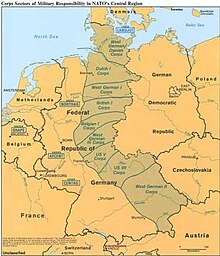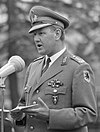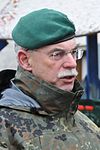Allied Joint Force Command Brunssum
| Joint Force Command Brunssum | |
|---|---|
 Coat of arms | |
| Active | AFCENT: 1953-2000 RHQ AFNORTH: 2000-2004 JFC-Brunssum: 2004-present |
| Part of | Allied Command Operations, Casteau, Belgium |
| Headquarters | Brunssum, Netherlands |
| Motto(s) | Many Nations: One Mission |
| Website | jfcbs |
| Commanders | |
| Commander | General Guglielmo Luigi Miglietta, Italian Army |
| Deputy Commander | Lieutenant General Luis Lanchares, Spanish Army |
| Chief of Staff | Lieutenant General Krzysztof Król, Polish Army |
| Command Sergeant Major | Chief warrant officer Stanley Ryan, Canadian Navy |
Allied Joint Force Command Brunssum (JFCBS) is a NATO command with its headquarters at Brunssum, the Netherlands. It was established in 2004 from previous commands as part of NATO's continuing command structure reductions in the face of a then-diminishing threat.
History
Allied Forces Central Europe from 1953

(48°24′10″N 2°42′8″E / 48.40278°N 2.70222°E) in 1965. Prior to World War II these offices housed the Artillery School.
Originally the command was known as Headquarters, Allied Forces Central Europe (AFCENT) when it was activated in August 1953 in Fontainebleau, outside Paris, France.[1]
Ensuring interoperability among land forces of the different NATO Member States has always been a challenge,[2] which is why a variety of NATO standardization activities, such as the NATO Standardization Office, have been underway since the 1950s.
After General Dwight D. Eisenhower was appointed as Supreme Allied Commander Europe (SACEUR) in 1950, he found that devising command arrangements in the Central Region, which contained the bulk of NATO’s forces, was to be complicated.[3] General Eisenhower considered naming an overall Commander-in-Chief (CINC) for the Central Region but soon realized it would be difficult to find an arrangement that would satisfy all three major powers with forces in the Centre - the United States, United Kingdom and France - because their views on the proper relationship of air and ground power differed significantly. Moreover, he wanted to control the most important region, Central Region, himself.[4]
Drawing upon his Second World War experience, Eisenhower decided to retain overall control himself and did not appoint a CINC for the Central Region. Instead there would be three separate commanders-in-chief (for Allied Air Forces Central Europe, Allied Land Forces Central Europe and Flag Officer Central Europe (FLAGCENT)), all reporting directly to SACEUR. Vice Admiral Robert Jaujard of the French Navy was appointed as Flag Officer Central Europe, and served from 2 April 51 until 20 August 1953.[5] On 20 August 1953 General Ridgeway, Eisenhower's successor, established a single Commander-in-Chief (CINCENT) for the region with subordinate land, air and naval commanders (COMLANDCENT, COMAIRCENT, and COMNAVCENT respectively).[1]

One of the command's exercises in the 1950s was Operation Counter Punch. Counter Punch was a September 1957 AFCENT air-ground military exercise that also tested NATO's integrated air-defense system in its central European front. The exercise involved the national air-defense systems of Britain, France, Belgium and the Netherlands, with Général d'Armée Jean-Étienne Valluy, French Army, NATO's Commander-in-Chief Allied Forces Central Europe (CINCENT), in overall command.[7] Operation Counter Punch revealed deficiencies in the Integrated NATO Air Defense System as well as air force responsiveness to theoretical Soviet and Warsaw Pact ground advances.[8]
After July 1962 and the establishment of Commander Allied Forces Baltic Approaches (COMBALTAP), German naval forces were shifted into that command.[3] Thereafter there was no longer any need for the small headquarters of Allied Naval Forces Central Europe and its two subordinate commands, and they were disestablished in 1962, leaving naval liaison provided by a US naval officer.[1]
AFCENT remained in France under French command until 1967, when France removed itself from the military command structure. The headquarters was moved to Brunssum in 1967 and activated under German command.[1]
Subordinate AFCENT commands in 1989


During the Cold War, AFCENT commanded the following units:
- Allied Command Europe, in Mons, Belgium
- Allied Forces Central Europe (AFCENT), in Brunssum, Netherlands
- Northern Army Group (NORTHAG), at JHQ Rheindahlen, West Germany
- Central Army Group (CENTAG), in Heidelberg, West Germany
- Allied Air Forces Central Europe (AAFCE), in Ramstein Air Base, West Germany
- Second Allied Tactical Air Force (2 ATAF)
- Fourth Allied Tactical Air Force (4 ATAF)
- Allied Forces Central Europe (AFCENT), in Brunssum, Netherlands
The III Corps (US) was allocated as NORTHAG reserve. On activation, it would have deployed to Europe from bases in the United States. A forward element, 3rd Brigade, US 2nd Armored Division, was located at Garlstedt, Germany.[9] The U.S. III Corps also maintained a forward headquarters at Tapijn Kazerne, Maastricht, Netherlands.[10]
The commander of US Army Europe, Gen. William W. Crouch, assumed an additional role as commander of NATO LANDCENT on 15 February 1996. He was the first American to command LANDCENT since its 1993 activation. Originally, the LANDCENT command was to be rotated between German and Dutch generals. The dual command of United States Army Europe (USAREUR) and LANDCENT allowed the continued integration of US Army Europe into NATO's post-Cold War structure. All NATO corps, except for the de:IV. Korps (Bundeswehr), were then multinational. In the mid-late 1990s there were four multinational main defence corps in NATO's Central Region: one Danish-German (LANDJUT), one Dutch-German (I GE/NL Corps) and two German-United States (II GE/US and V US/GE). In addition, an agreement was made which set out the arrangements under which the European Corps, consisting of units from Belgium, France, Germany, Luxembourg and Spain, would be made available to NATO in times of crisis.
LANDCENT's missions were to:[11]
- Protect the peace and deter aggression in NATO's central region (Germany, Belgium, Luxemburg and the Netherlands).
- Plan, prepare and direct operations of land forces under NATO command.
- Plan, coordinate and conduct the land and air subcampaign jointly with NATO's Allied Air Command, Central.
- Develop plans for, and participate in, the MCP and Partnership for Peace (PfP) initiative.
- Support the flanks of the area of responsibilities.
The departure from the Cold War era brought the implementation of a new NATO Integrated Military Structure and LandCENT was formally designated Joint Headquarters Centre (JHQ CENT) in a ceremony held on March 9, 2000.[12]
Establishment of JFC Brunssum
In 2000, the deactivation of Headquarters, Allied Forces Northern Europe (AFNORTH) in Kolsås, Norway led to the redesignation of AFCENT as Regional Headquarters, Allied Forces Northern Europe (RHQ AFNORTH). The headquarters operated as RHQ AFNORTH until 2004, when it was renamed Allied Joint Force Command Brunssum (JFC-B) to add flexibility to the military command structure by removing regional restrictions.[13]
Circa 2010, JFC Brussum appears to be responsible for Contingency Plan Eagle Guardian, NATO's Article 5 plan to defend Poland, Lithuania, Latvia, and Estonia.[14]
Until March 2013 Command Component Land Heidelberg (FC Heidelberg (Land)), the land component command, was under the control of this headquarter and located at Heidelberg in Germany.
Facilities

Hendrik van Nassau-Ouwerkerk Camp
Hendrik van Nassau-Ouwerkerk Camp is the headquarters and main base area of JFC Brunssum.[15] Other organizations located on Hendrik van Nassau-Ouwerkerk Camp are the NATO Communication and Information Systems Services Agency, Sector Brunssum (NCSA-B)[16] and the NATO Airborne Early Warning & Control Programme Management Agency (NAPMA).[17]
Hendrik van Nassau-Ouwerkerk Camp also boasts an all ranks club called Club 13, a small tax-free department store called the B&S Store, a film theatre, a swimming pool, tennis courts and a gymnasium. Additional services are provided by the AAFES on US Army Garrison Brunssum.[18]
Static War Headquarters Castlegate
Static War Headquarters Castlegate is a NATO command and communications bunker located approximately 2 km north-east of the town of Linnich, Germany.[19] SWHQ Castlegate is operated in caretaker status by a German military contingent.[20]
Commanders
The commander of JFC-B is known as Commander, Joint Force Command Brunssum. The position was formerly known as Commander-in-Chief North (CINCNORTH) and Commander-in-Chief Central (CINCCENT). JFC-B is normally commanded by a German General. Two Italian four-star generals commanded JFC-B for the great contribution of the Italian armed forces to NATO. The first five commanders were French. The current commander is General Jörg Vollmer of the German Army.
| No. | Portrait | Name | Title | Took office | Left office | Time in office | Country |
|---|---|---|---|---|---|---|---|
| 1 | Alphonse Juin (1888–1967) | Commander in Chief, Allied Forces Central Europe | 20 August 1953 | September 1956 | 3 years | ||
| 2 | Jean Étienne Valluy (1899–1970) | Commander in Chief, Allied Forces Central Europe | October 1956 | May 1960 | 3 years, 7 months | ||
| 3 | Maurice Challe (1905–1979) | Commander in Chief, Allied Forces Central Europe | May 1960 | February 1961 | 9 months | ||
| 4 | Pierre-Elie Jacquot (1902–1984) | Commander in Chief, Allied Forces Central Europe | March 1961 | December 1963 | 2 years, 10 months | ||
| 5 | Jean Albert Emile Crépin [a] | Commander in Chief, Allied Forces Central Europe | December 1963 | June 1966 | 2 years, 6 months | ||
| 6 | Johann Adolf Graf von Kielmansegg (1906–2006) | Commander in Chief, Allied Forces Central Europe | 15 March 1967 | 1 April 1968 | 1 year | ||
| 7 | Jürgen Bennecke (1912–2002) | Commander in Chief, Allied Forces Central Europe | 1 July 1968 | 30 September 1973 | 5 years, 2 months | ||
| 8 | Ernst Ferber (1914–1998) | Commander in Chief, Allied Forces Central Europe | 1 October 1973 | 30 September 1975 | 1 year, 11 months | ||
| 9 | Karl Schnell (1916–2008) | Commander in Chief, Allied Forces Central Europe | 1 October 1975 | 7 January 1977 | 1 year, 3 months | ||
| 10 | Franz-Joseph Schulze (1918–2005) | Commander in Chief, Allied Forces Central Europe | 7 January 1977 | 30 September 1979 | 2 years, 8 months | ||
| 11 | Ferdinand von Senger und Etterlin (1923–1987) | Commander in Chief, Allied Forces Central Europe | 1 October 1979 | 28 September 1983 | 3 years, 11 months | ||
| 12 | Leopold Chalupa (born 1927) | Commander in Chief, Allied Forces Central Europe | 28 September 1983 | 1 October 1987 | 4 years | ||
| 13 | Hans-Henning von Sandrart (1933–2013) | Commander in Chief, Allied Forces Central Europe | 1 October 1987 | 27 September 1991 | 3 years, 11 months | ||
| 14 | Henning von Ondarza (born 1933) | Commander in Chief, Allied Forces Central Europe | 27 September 1991 | 23 March 1994 | 2 years, 5 months | ||
| 15 | Helge Hansen (born 1936) | Commander in Chief, Allied Forces Central Europe | 1 April 1994 | March 1996 | 1 year, 11 months | ||
| 16 | Dieter Stöckmann (born 1941) | Commander in Chief, Allied Forces Central Europe | March 1996 | 30 March 1998 | 2 years | ||
| 17 | Joachim Spiering (born 1940) [b] | Commander in Chief Allied Forces North Europe | 30 March 1998 | March 2001 | 2 years, 11 months | ||
| 18 | Sir Jack Deverell (born 1945) | Commander in Chief Allied Forces North Europe | March 2001 | January 2004 | 2 years, 10 months | ||
| 19 | Gerhard W. Back (born 1944) [c] | Allied Joint Force Command Brunssum | January 2004 | 26 January 2007 | 3 years | ||
| 20 | Egon Ramms (born 1948) | Allied Joint Force Command Brunssum | 26 January 2007 | 29 September 2010 | 3 years, 8 months | ||
| 21 | Wolf-Dieter Langheld (born 1950) | Allied Joint Force Command Brunssum | 29 September 2010 | 14 December 2012 | 2 years, 2 months | ||
| 22 | Hans-Lothar Domröse (born 1952) | Allied Joint Force Command Brunssum | 14 December 2012 | 3 March 2016 | 3 years, 2 months | ||
| 23 | Salvatore Farina (born 1957) | Allied Joint Force Command Brunssum | 4 March 2016 | 16 February 2018 | 1 year, 11 months | ||
| 24 | Riccardo Marchiò (born 1955) | Allied Joint Force Command Brunssum | 16 February 2018 | 31 March 2019 | 6 years, 9 months | ||
| 25 | Erhard Bühler (born 1956) | Allied Joint Force Command Brunssum | 31 March 2019 | 22 April 2020 | 1 year | ||
| 26 | Jörg Vollmer (born 1957) | Allied Joint Force Command Brunssum | 22 April 2020 | 3 June 2022 | 2 years, 1 month | ||
| 27 | Guglielmo Luigi Miglietta (born 1961) [21] | Allied Joint Force Command Brunssum | 3 June 2022 | Incumbent | 2 years, 5 months |
Notes
References
- ^ a b c d "Allied Forces Central Europe". Retrieved 21 June 2014.
- ^ Derleth, James (16 June 2015). "Enhancing interoperability: the foundation for effective NATO operations". NATO Review. Retrieved 23 June 2022.
- ^ a b Dr Gregory Pedlow, Evolution of NATO's Command Structure
- ^ "Forging the Weapon: The origins of SHAPE" (PDF). NATO. 7 December 2012. p. 15. Retrieved 8 March 2022.
- ^ North Atlantic Treaty Organization, Senior officials in the NATO military structure, from 1949 to 2001 (PDF)
- ^ "Allied Forces Central Europe (AFCENT), NATO - Coat of arms (crest) of the Allied Forces Central Europe (AFCENT), NATO". Heraldry-wiki.com. Retrieved 2019-10-19.
- ^ "Emergency Call". Time. 30 September 1957. Archived from the original on June 28, 2011. Retrieved 3 October 2008.
- ^ Trauschweizer, Igor (2006). Creating Deterrence for Limited War: The U.S. Army and the Defense of West Germany, 1953–1982 (PDF). College Park, Maryland: University of Maryland. p. 179. Retrieved 16 June 2011.
- ^ David Isby; Charles Kamps (1985). Armies of NATO's Central Front. Jane's Publishing Company. pp. 373, 455. ISBN 0-7106-0341-X.; U.S. Army Europe (22 May 1980). Strengthening NATO: Stationing of the 2nd Armored Division (Forward) in Northern Germany (PDF). Archived from the original (PDF) on 2009-03-27.
- ^ Simon Duke, U.S. Military Forces and Installations in Europe, SIPRI/Oxford University Press, 1989, p. 20 - 30 ish.
- ^ Crouch adds NATO role. Vol. 51. Soldiers. 1 April 1996. p. 7. Retrieved 23 June 2022.
- ^ Allied Land Component Headquarters Heidelberg, History of the Headquarters, updated September 15, 2004
- ^ "What is JFC Brunssum?". NATO. Archived from the original on 12 August 2014. Retrieved 21 June 2014.
- ^ Wikileaks/The Guardian, search Eagle Guardian
- ^ AFNORTH: About us Archived October 10, 2010, at the Wayback Machine
- ^ NATO Communication and Information Systems Services Agency Archived July 10, 2010, at the Wayback Machine
- ^ "NAPMA | NATO AEW&C Programme Management Agency | Homepage". Napma.nato.int. Retrieved 2013-04-07.
- ^ "Army and Air Force Exchange Service (AAFES) locations". US Army Garrison Benelux. Retrieved 8 March 2022.
- ^ "Militärstandorte um und in Aachen". Users.cuci.nl. Archived from the original on 2015-10-26. Retrieved 2013-04-07.
- ^ Joint Force Command Brunssum Team [dead link]
- ^ "Commander JFC-Brunssum".
External links



![Pierre-Elie Jacquot [fr]](http://upload.wikimedia.org/wikipedia/commons/thumb/3/38/Jacquot_pierre_elie_1961_grand_croix.jpg/100px-Jacquot_pierre_elie_1961_grand_croix.jpg)

![Jürgen Bennecke [de]](http://upload.wikimedia.org/wikipedia/commons/thumb/e/e4/Nieuwe_commandant_Afcent_te_Brunssum._Generaal_Bennecke_tijdens_persconferentie%2C_Bestanddeelnr_921-2116.jpg/100px-Nieuwe_commandant_Afcent_te_Brunssum._Generaal_Bennecke_tijdens_persconferentie%2C_Bestanddeelnr_921-2116.jpg)
![Ernst Ferber [de]](http://upload.wikimedia.org/wikipedia/commons/thumb/f/fd/Bundesarchiv_Bild_183-C0612-0046-001%2C_Ernst_Ferber.jpg/100px-Bundesarchiv_Bild_183-C0612-0046-001%2C_Ernst_Ferber.jpg)
![Karl Schnell [de]](http://upload.wikimedia.org/wikipedia/commons/thumb/e/e6/Bundesarchiv_B_145_Bild-F039688-0018%2C_Bonn%2C_Bundespr%C3%A4sident_mit_Generalleutnant_Schnell_%28cropped%29.jpg/100px-Bundesarchiv_B_145_Bild-F039688-0018%2C_Bonn%2C_Bundespr%C3%A4sident_mit_Generalleutnant_Schnell_%28cropped%29.jpg)
![Leopold Chalupa [de]](http://upload.wikimedia.org/wikipedia/commons/thumb/e/e1/Leopold_Chalupa_%28cropped%29.jpg/100px-Leopold_Chalupa_%28cropped%29.jpg)
![Henning von Ondarza [de]](http://upload.wikimedia.org/wikipedia/commons/thumb/f/f9/Henning-von-Ondarza.jpg/100px-Henning-von-Ondarza.jpg)

![Gerhard W. Back [de]](http://upload.wikimedia.org/wikipedia/commons/thumb/b/bb/DF-SD-04-02365_US_Brigadier_General_Mark_A._Volcheff%2C_German_Lieutenant_General_Gerhard_Back%2C_and_Herr_Klaus_Layes%2C_Mayor_of_Ramstein-Misenbach_%28cropped%29.jpg/100px-DF-SD-04-02365_US_Brigadier_General_Mark_A._Volcheff%2C_German_Lieutenant_General_Gerhard_Back%2C_and_Herr_Klaus_Layes%2C_Mayor_of_Ramstein-Misenbach_%28cropped%29.jpg)

![Wolf-Dieter Langheld [de]](http://upload.wikimedia.org/wikipedia/commons/thumb/f/f7/General_Wolf-Dieter_Langheld%2C_2011_%28cropped%29.jpg/100px-General_Wolf-Dieter_Langheld%2C_2011_%28cropped%29.jpg)





